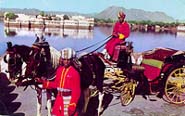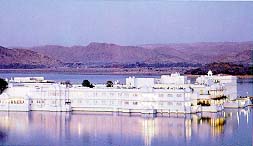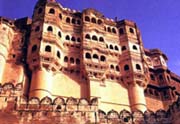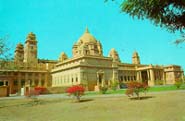Rajasthan- The land of princes...of legends... of glory...
Anvar Alikhan
 The maharanas of Udaipur are perhaps the oldest dynasty in the
world, tracing their ancestry back, through 76 generations, to
the year 566 AD. And of all the Rajput kings, they were ultimately
the only ones who refused to bend their knees to the Mughal emperors
in Delhi. For decades they fought a hit and run guerilla war with
the Mughal armies in the hills of southern Rajasthan.
The maharanas of Udaipur are perhaps the oldest dynasty in the
world, tracing their ancestry back, through 76 generations, to
the year 566 AD. And of all the Rajput kings, they were ultimately
the only ones who refused to bend their knees to the Mughal emperors
in Delhi. For decades they fought a hit and run guerilla war with
the Mughal armies in the hills of southern Rajasthan.

 Rajasthan is India's westernmost state, forming a large part of
its border with Pakistan, from the marshes of Kutch in the south,
through the great Thar desert, to the plains of the Punjab in
the north. The state covers an area of over 130,000 square miles,
and falls, very broadly, into three parts. In the west, of course,
lie the deserts of Marusthali or Marwar (The land of the Dead),
covering an area of 80,000 square miles. It is a unique desert
ecosystem, with a sandy, rocky terrain, where thorny bushes and
hardy trees, such as the Acacia nilotica and Prosopis cineraria
Rajasthan is India's westernmost state, forming a large part of
its border with Pakistan, from the marshes of Kutch in the south,
through the great Thar desert, to the plains of the Punjab in
the north. The state covers an area of over 130,000 square miles,
and falls, very broadly, into three parts. In the west, of course,
lie the deserts of Marusthali or Marwar (The land of the Dead),
covering an area of 80,000 square miles. It is a unique desert
ecosystem, with a sandy, rocky terrain, where thorny bushes and
hardy trees, such as the Acacia nilotica and Prosopis cineraria grow. In the centre, running like a vast diagonal slash across
the state, lie the sharp, craggy conical hills of the Aravalli
range. And to the east lie forests, river valleys and plains that
merge southwards into the Vindhya hills of Central India.
grow. In the centre, running like a vast diagonal slash across
the state, lie the sharp, craggy conical hills of the Aravalli
range. And to the east lie forests, river valleys and plains that
merge southwards into the Vindhya hills of Central India.
|
It was only
when a Mughal prince whom the maharanas had once sheltered, while
he was in exile, ascended the throne in Delhi that peace finally
came. And it brought with it a renaissance of the arts and architecture
in Udaipur, which resulted in the building of some spectacular
palaces.
The City Palace
The greatest of Udaipur's palaces is the City Palace. Built on
the lakeside in the classic Rajput style, it presents a stern
front of high walls topped with cupolas and watchtowers.
But once
inside the forbidding walls you come upon a succession of palaces
which had become more and more decorative and ornate as the centuries
passed, with fine mosaics, frescoes and mirror work, including --
in one suite -- a mirror-worked floor!
There is also a hanging garden
inside, where, astonishingly, you discover full grown trees flourishing
90 feet above the ground.
Jag Niwas and Jag Mandir
While the City Palace is undoubtedly impressive, what is truly
unforgettable about Udaipur is the 18th century pleasure palace
of Jag Niwas, floating in the centre of the
Pichola Lake, like some great white marble water lily (see the picture immediately below). Covering
an area of four acres, it has pavilions crowned with cupolas and gardens populated with fountains. These are laid out around apartments
elaborately decorated with cusped arches, frescoes, mirror work
and stained glass. Today it has been converted into a luxury hotel
-- perhaps the most beautiful hotel in the world.
 Nearby is the older water palace of Jag Mandir, built in 1620,
where the Mughal prince Khurram lived briefly while in exile.
When he later ascended the throne and became the Emperor Shah
Jehan, he went on to build the Taj Mahal, and it is said that
the inspiration for it actually came originally from this small
marble palace. Nearby is the older water palace of Jag Mandir, built in 1620,
where the Mughal prince Khurram lived briefly while in exile.
When he later ascended the throne and became the Emperor Shah
Jehan, he went on to build the Taj Mahal, and it is said that
the inspiration for it actually came originally from this small
marble palace.
Around Udaipur
Beyond Udaipur lies the rest of the historic kingdom of Mewar,
of which the city was once the capital. It is a region that is
scattered with formidable fortresses and fascinating temples.
Deep in a forest 60 miles north of Udaipur is the awe inspiring
15th century Ranakpur temple. Its 29 halls cover over 4,000 square
yards and its dome is supported by a veritable forest of 420 columns.
It is so complex in form and so overwhelming in size that it leaves
you slightly bewildered when you first step in.
But what is probably
even more bewildering is the sheer profusion of intricate carving
that covers every surface -- the walls, the ceilings, the pillars,
and even the supporting brackets of the domes. Wherever you look
you see scrollery, floral motifs, dancing goddesses and geometric
forms, all wrought so finely that it resembles lacework rather
than stone carving.
Just one indication of the exuberance of the
workmanship is the fact that when you look closely, you'll find
that no two of the temple's 420 pillars is the same; each one
is carved in a different pattern and style.
Kumbhalgarh Fort
Not far from Ranakpur is the impregnable 15th century fortress
of Kumbhalgarh. Its endless battlements thread their way through
the surrounding hillsides, enclosing an area of 32 square miles.
In their conception they have been compared to the Great Wall
of China, for they were designed in such a way that eight horsemen
could ride abreast along the top of the ramparts.
Within this
outer wall, a system of six other concentric walls rises, layer
by layer, to Kumbhalgarh's citadel, leaving you with no doubt
whatsoever why, in all its 400 years of active service, the fort
never once fell to its various assorted enemies. Even the great
armies of the Mughal Emperor Akbar could only penetrate as far
is its second wall, and no farther.
Right at the citadel lies
Badal Mahal, literally, "The Palace in the Clouds", with its delicate
pastel murals. It is, alas, the only one of the 252 palaces, great
and small, that are said to have once filled this vast fortress
city.
Jodhpur
 Jodhpur lies deep in the shifting deserts of Marwar or "The Land of the Dead". It is a city that is much older than
Jaipur or Udaipur, for it was founded in 1459 by a chieftain of
the powerful Rathore clan. As always in Rajasthan, there is a
legend attached to the city. For it is said that when Rao Jodha,
its founder, erected his fort on a steep rocky hill here, he had
to displace a hermit who had been meditating on this spot for
years.
Jodhpur lies deep in the shifting deserts of Marwar or "The Land of the Dead". It is a city that is much older than
Jaipur or Udaipur, for it was founded in 1459 by a chieftain of
the powerful Rathore clan. As always in Rajasthan, there is a
legend attached to the city. For it is said that when Rao Jodha,
its founder, erected his fort on a steep rocky hill here, he had
to displace a hermit who had been meditating on this spot for
years.
The angry hermit placed a curse on Rao Jodha and his descendants
saying that henceforth they would be struck by famine and drought
every year. The hermit was later placated, but the curse couldn't
be withdrawn completely -- which is, they say, the reason why Jodhpur
still suffers from drought every three to four years.
Mehrangarh Fort
The walls and towers of Mehrangarh Fort seem to grow organically
out of the living rock face of Bukarchiriya Hill, which looms
400 feet above the surrounding desert. The approach to the fortress is guarded by a concentric of seven gateways and a cunningly laid zigzag path designed to thwart even
the most determined attack.

|
 The predominant religion of Rajasthan is, of course, Hinduism.
However it is perhaps Hinduism with a slightly different flavour,
for the dominant force within their Hindu society was the warrior caste
of the Rajput kshatriyas rather than the priestly Brahmins,
as was the case in most of the rest of India. Another interesting
religious feature of Rajasthan is the various folk cults that
have developed and flourished here, based on local deities and
folk heroes, such as Pabuji, Ramdeoji, Gogaji Mehaji, Harbhuji,
and Tejaji. Other significant religious groups in the state are
the Jains ands the Muslims.
The predominant religion of Rajasthan is, of course, Hinduism.
However it is perhaps Hinduism with a slightly different flavour,
for the dominant force within their Hindu society was the warrior caste
of the Rajput kshatriyas rather than the priestly Brahmins,
as was the case in most of the rest of India. Another interesting
religious feature of Rajasthan is the various folk cults that
have developed and flourished here, based on local deities and
folk heroes, such as Pabuji, Ramdeoji, Gogaji Mehaji, Harbhuji,
and Tejaji. Other significant religious groups in the state are
the Jains ands the Muslims.
|
Inside the citadel is a series of
beautiful palaces, built by succession of maharajas between the
15th and late 19th centuries. These palaces are known especially
for their carved sandstone latticework screens, so delicate that
they look like "layer upon layer of hanging rose pink lace".
There
was obviously a function behind the form, for these screens were
designed to allow the princesses of the palace to look upon the
outside would without themselves being seen by strange unauthorised
eyes. To see a picture of the fort click here or here.
Within the sandstone palaces are the royal halls, chambers and suites
which are decorated with ornate mirrored inlays, lacquer work murals,
multicoloured glass panels and gilt. In one of the halls alone
nearly 50 pounds of gold is said to have been used to gild the
walls!
Housed within the palace complex, also, is the royal museum
which contains the heirlooms of the Rathore dynasty, including
old palanquins, elephant howdahs, miniature paintings, the usual
terrifying Rajput weaponry and ornate cradles in which centuries
of little princes and princesses were once rocked. But perhaps
most fascinating of all is the collection of over a hundred different
styles of turbans from the various regions of Rajasthan, which
vividly brings to life the adage that in this region "the style
of turban changes every four miles".
On the fort's ramparts, meanwhile,
is a battery of great medieval cannons, once feared throughout
Rajasthan. And beyond these is a spectacular view of the burning
desert all around. In fact, on a clear day you can even see the
rival fortress of Kumbhalgarh, the stronghold of the Rathores'
traditional enemies, the Sisodias of Udaipur, shimmering menacingly
in the heat haze over 80 miles away.
Umaid Bhawan Palace
 The gigantic Umaid Bhawan Palace has the distinction of having
once been the largest private residence in the world, with its
347 rooms(see the picture at the right). Built in the 1920s it looks like something Albert
Speer might have designed for Adolf Hitler's Thousand Year Reich.
And it prompted film director James Ivory to once observe that
in a couple of hundred years, it would probably become one of
the great ruins of India, like the ghost city of Fatehpur Sikri.
Today it has been turned into a luxury hotel.
The gigantic Umaid Bhawan Palace has the distinction of having
once been the largest private residence in the world, with its
347 rooms(see the picture at the right). Built in the 1920s it looks like something Albert
Speer might have designed for Adolf Hitler's Thousand Year Reich.
And it prompted film director James Ivory to once observe that
in a couple of hundred years, it would probably become one of
the great ruins of India, like the ghost city of Fatehpur Sikri.
Today it has been turned into a luxury hotel.
|

